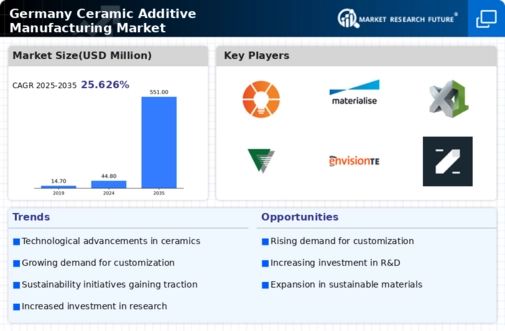The Germany Ceramic Additive Manufacturing Market has witnessed significant growth due to the increasing demand for advanced manufacturing techniques that enhance design flexibility and operational efficiency. This market is characterized by a diverse array of players ranging from established companies to innovative start-ups, each contributing to a competitive landscape driven by technological advancements. The focus on optimizing production processes for industries such as aerospace, automotive, and healthcare has further intensified competition among market participants.
Moreover, the evolving regulatory landscape and emerging trends in sustainability and environmentally friendly materials have added layers of complexity to market strategies, compelling businesses to innovate continuously and adapt to consumer preferences swiftly. EOS has established a formidable presence in the Germany Ceramic Additive Manufacturing Market, positioning itself as a key player synonymous with high-quality and reliable solutions. The company's strengths lie in its cutting-edge technology that facilitates the production of intricate ceramic components with precision. EOS's commitment to research and development enables it to maintain a competitive edge through constant innovation, ensuring that its offerings align with industry needs.
The German market has benefitted from EOS’s robust customer support and training programs, fostering strong relationships with clients. This focus on client collaboration, coupled with a reputation for durable, high-performance products, allows EOS to navigate the complexities of the ceramic additive manufacturing landscape effectively. Materialise is another significant entity in the Germany Ceramic Additive Manufacturing Market, recognized for its comprehensive suite of software tools and consulting services that enhance additive manufacturing workflows. The company offers innovative solutions that encompass the entire process, from design to production, tailored specifically for ceramic applications.
With a strong focus on enhancing user experience, Materialise provides exceptional support to its customers, ensuring they maximize the potential of ceramic additive technologies. Its market presence is bolstered by strategic partnerships and collaborations with leading manufacturers, coupled with a commitment to sustainability through innovative recycling solutions. Materialise also engages in mergers and acquisitions to bolster its technological capabilities and extend its market footprint in Germany, further cementing its role in the evolution of this sector.






















Leave a Comment